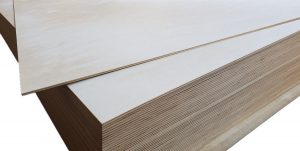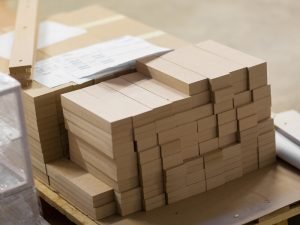Plywood production involves a number of processes. These include debarking, peeling, core composing, gluing, pressing, and drying etc.
Debarking
Debarking is the process of removing bark from logs before they are used for production. It can help ensure the wood is dry and ready for use, as the bark can contain moisture that will rot the logs. It also helps the lumber dry out more quickly, which is important if you want to make furniture or other wood products with a low moisture content.
During debarking, logs are placed into a machine with a set of ridged wheels (known as rifters) that spin on the inside surface of the machine. The ridges cause the logs to tumble against each other and cut the bark off.
There are many different types of debarkers, but they all operate in the same way. These include drum debarkers, roller debarkers, and rosserhead debarkers.
Drum debarkers are older machines that were designed to handle large volumes of lumber. They are on-mass systems, meaning you can feed multiple logs into the machine at once.
Roller debarkers, on the other hand, were developed in the late 1980s and early 1990s. They are similar to drum debarkers but operate differently.
In a roller debarker, logs are fed into a machine with a series of cylinder-shaped ridged wheels. As the ridges rotate on the inside surface of the machine, they cause the logs to tumble against each other. These ridges also act like small hammers that cut the bark off.
Although these ridged wheels are very effective at removing the bark, they can’t do so as well as a high-end rosserhead debarker. This is because the ridges on the machine can’t provide a uniform finish, and they don’t remove as much bad fiber. However, they do offer a faster throughput rate than rosserhead debarkers.
Peeling
The plywood manufacturer peels veneers, which are thin sheets of wood, using a rotary peeling machine. This process removes bark from logs and improves cross-section roundness. It also cuts down on the amount of gluing required to make veneers.
Once the peeler is finished, the logs are sent to a drying oven. After the ply is dried, it is sanded to smooth out any imperfections and trim it to size. The sanded veneer is then ready for packaging and assembling.
There are several factors that affect the quality of plywood, including log selection and peeling. The manufacturer’s goal is to produce veneer from species with acceptable physical and aesthetic characteristics.
After log selection, the manufacturer must ensure that the trees have the correct shape and width. This will help determine how many logs will be needed to make the desired plywood.
Next, the logs must be debarked to prevent moisture from getting in the way of the peeling process. The manufacturer can use different types of debarkers, such as Rosser head or ring debarkers, depending on the log’s size.
Regardless of the type of debarking machine, it is important that the logs are not damaged in any way during the process. Damaging the ends of logs can cause issues when gluing them together.
In addition, logs with varying diameters and lengths must be processed in the same way. This is a challenge, but it can be addressed with the use of specialized equipment.
For this reason, the plywood manufacturer uses a variety of machining techniques to get the best possible finish on its products. It can then use these veneers to produce a variety of products, such as cabinets, desks, and shelving.
Composing
Plywood is a manmade material made of layers of wood veneers that are glued together. It can be used for a wide variety of applications, from furniture to boxes and cabinets.
It is made from a combination of hardwoods and softwoods, including pine and fir. Its strength and durability are superior to solid wood, because it resists cracking, shrinkage, twisting, and warping.
Typically, plywood has two outer layers: a face and a back, but it can also have a core layer in the center. Depending on the type of plywood, the number of plies may vary. The additional layers, called crossbands, help keep the grain of each of the layers straight, preventing moisture from causing the wood to expand or contract across the grain.
The adhesive that is used to glue the layers of wood together is a key factor in the strength and durability of the final product. Different types of adhesive are used depending on the intended use of the plywood sheet. For example, if the plywood is to be used for the exterior of a structure, the adhesive will usually be made with a phenol-formaldehyde resin.
Once the layers of wood are glued together, they are then placed perpendicular to one another and pressed using a hot press. This process ensures that the glue is fully cured, thus firmly joining the layers together.
During the drying stage, plywood is often exposed to high levels of air pollution. This is because it is being pressed and dried in a way that releases a large amount of formaldehyde into the air. This can cause a range of health problems, from respiratory issues to cancer.
Pressing
Pressing is the next step in the plywood production process. It consists of pressing veneers with a variety of adhesives to produce finished products that are resistant to moisture. It also enables manufacturers to achieve higher productivity.
During this process, wood species and veneer surface properties determine the appropriate adhesive to use. For instance, phenolic formaldehyde resin adhesives are often used to make moisture-resistant plywood. This type of adhesive is also a good choice for bonding veneers without the need for chemical treatment.
The temperature, pressing time, and pressure during hot pressing are variable depending on the desired characteristics of the final product (e.g., thickness tolerance). A quadratic polynomial model is often used to calculate these parameters.
For the production of plywood, the following pressing parameters are typically used: temperature from 115 to 140 degC, pressure 0.8 MPa for softwoods and 1.5 MPa for hardwoods, holding time under pressure 6 minutes, and adhesive consumption 160 to 230 g/m2. The chosen pressing pressure depends on the wood species and physical properties, but it should be lower than the applied pressure during the processing of the veneer [9,10].
The densification process smooths the surface of the veneer, decreasing its roughness and increasing its density and porosity. Moreover, it increases the strength of the plywood. This can help reduce the amount of adhesive needed for bonding, which is beneficial for production.
Drying
The drying process is one of the most important steps in making plywood. It reduces the weight of veneers and makes them more resistant to cracking, pest infestation, and warping. It also improves the quality of wood panels and allows them to be stored for longer periods of time without losing their strength or durability.
To dry the veneers, manufacturers have several options: hot-pressing, vacuum drying, and air drying. The former two methods are generally preferred due to their lower production costs, high capacity, and quick drying.
However, the process of drying the veneers can cause defects that will affect the quality and durability of the panels. These defects include blisters, glue penetration, and peeling.
Some of these defects are easily visible (cracks and deformations) while others are less obvious but may lead to future failure [1, 2]. To address this problem, researchers have developed various techniques for gluing green veneers that can be used in the industrial production of plywood.
Among these, finite element simulations have been performed to study how the internal structure and properties of green-glued panels affect their shape stability during the drying process. The results obtained can help predict the shape stability of these products, especially in the presence of flexural deformations and internal stresses that could be difficult to observe experimentally.
In addition, the use of numerical models has been proposed to simulate the drying kinetics and hydro-mechanical behavior of green-glued panels in order to forecast their material integrity and shape stability. This can be useful to plan the drying program before putting it into practice and avoid producing green-glued plywood with significant levels of material integrity or shape instability.


